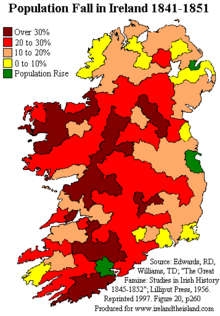
The population of Ireland in 2021 was approximately seven million with 1,903,100 in Northern Ireland[1] and 5,123,536 in the Republic of Ireland.[2] In the 2022 census the population of the Republic of Ireland eclipsed five million for the first time since the 1851 census.[3] The population of Ireland in 2024 was approximately 7.2 million (5.35 million in the Republic of Ireland and 1.91 million in Northern Ireland). Although these figures demonstrate significant growth over recent years, the population of Ireland remains below the record high of 8,175,124 in the 1841 census.[4]
Between 1700 and 1840, Ireland experienced rapid population growth, rising from less than three million in 1700 to over eight million by the 1841 census.[5] In 1851, as the Great Famine was ending, the population of Ireland had dropped to 6.5 million people. The Famine and the resulting Irish diaspora had a dramatic effect on population; by 1891, Ireland's population had slipped under five million and by 1931, it had dropped to just over four million. It stayed around this level until the 1960s, when the population began to rise again.
Below are some statistics to illustrate the rise, fall and rise again of the population since 1841. The statistics also illustrate a massive population shift from the west to the east of the country and increasing urbanisation. The areas around Dublin and Belfast have seen population growth, while Connacht has become depopulated.
- ^ "Census Results NI Released May 2022" (PDF). NISRA.
- ^ "Census Results RoI Released June 2022". CSO.
- ^ "Ireland's population is now the biggest since before the Famine, census reveals". Irish Central. 24 June 2022. Retrieved 18 July 2022.
- ^ "Press Statement Census of Population 2022 – Preliminary Results". Central Statistics Office. Retrieved 18 July 2022.
- ^ Ó Grada Cormac. The population of Ireland 1700–1900 : a survey. In: Annales de démographie historique, 1979. p. 283.